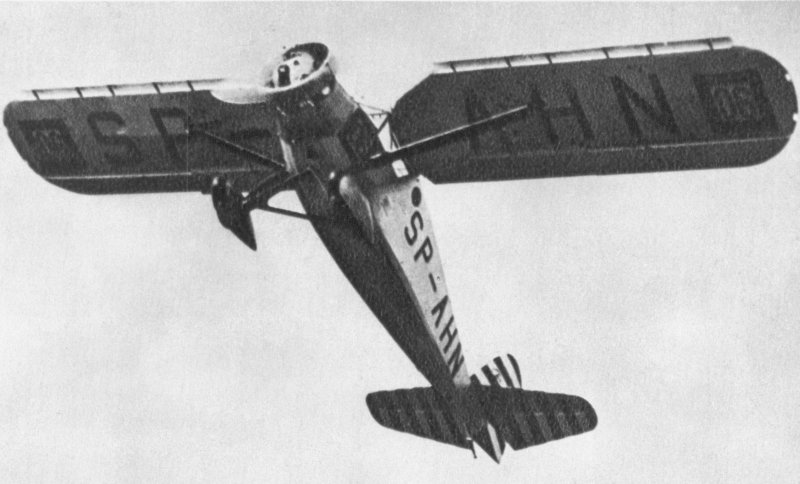- RWD-6
infobox Aircraft
name =RWD-6
type =Sports plane
manufacturer =Warsaw University of Technology workshops
caption =RWD-6 of Franciszek Zwirko during a short take-off trial at the Challenge 1932
designer = RWD team
first flight =1932-06-03
introduced =1932
retired =1935
status =
primary user =Polish civilian aviation
more users =
produced =
number built =3
unit cost =
variants with their own articles = The RWD-6 was a Polishsports plane of 1932, constructed by the RWD team. It was a winner of theChallenge 1932 international tourist aircraft contest.Development
The aircraft was designed specially for the purpose of competing in the international tourist aircraft contest Challenge, which RWD attended in 1930, without major success. It was constructed by the RWD team of
Stanislaw Rogalski ,Stanislaw Wigura andJerzy Drzewiecki in the workshops of Students' Mechanical Club of Warsaw University of Technology (their designs were named RWD after their initial letters). The new plane differed from previous RWD designs, having a cab with two seats next to each other, folding wings and good wing mechanization (slats andflap s).Only three aircraft were built, the first one was flown on
June 3 ,1932 by its designer Jerzy Drzewiecki. The aircraft were given civilian registrations SP-AHL, SP-AHM and SP-AHN. During trials, SP-AHM crashed and Drzewiecki was hurt. After some modification of the tail, the two remaining RWD-6s were sent to the Challenge contest.Challenge 1932 , held betweenAugust 11 -August 28 ,1932 , was eventually won byFranciszek Żwirko (pilot) andStanisław Wigura (mechanic) in their RWD-6 SP-AHN, with a start number O6. The other RWD-6, flown by Tadeusz Karpiński, took ninth place out of 43 competitors (SP-AHL, nr. O4). During contest, the RWD-6 was given the highest scores for technical evaluation of all participating aircraft. OnSeptember 11 ,1932 , the RWD-6 SP-AHN with Franciszek Żwirko and Stanisław Wigura aboard, crashed during a storm while flying to an air meeting in Czechoslovakia. Both died. The cause was found to be weak wing mountings, that caused wing warping at higher speeds. The last remaining RWD-6 (SP-AHL) was modified after this accident, receiving a strengthened wing with V-shapedstrut s and the new designation RWD-6bis. The RWD-6bis was completed and flown in September 1933. In 1935 it was broken up, and its fuselage was used to create theRWD-13 touring plane prototype. A direct development of the RWD-6 as a sport plane was a four-seaterRWD-9 , a winner of theChallenge 1934 .Description
Two-seater sports and touring strutted high-wing
monoplane of a mixed construction. A metal frame fuselage covered withcanvas , with the engine clad inaluminium sheets. Rectangular single-spar wing of wooden construction, canvas and plywood covered. Wings folded rearwards, and were equipped with automaticslats andflap s. Closed cabin with two seats side-by-side, with dual controls. The cabin had a pair of doors. 7-cylinderArmstrong Siddley Genet Major radial engine of 104 kW (140 hp) (119 kW, 160 hp start power). Two-blade metal propeller. Conventionallanding gear , with a rear skid. Fuel tanks in wings (140 l, 34 US gal). Take-off: 111 m (to altitude 8 m), landing: 106 m (from altitude 8 m - best results from the Challenge contest).pecifications
aircraft specifications
plane or copter?=plane
jet or prop?=prop
crew=1
capacity=1
length main=6.6 m
length alt=21 ft 8 in
span main=11.0 m
span alt=36 ft 1 in
height main=2.07 m
height alt=6 ft 9 in
area main=16.00 m²
area alt= 172 ft²
empty weight main= 474 kg
empty weight alt= 1,045 lb
loaded weight main=
loaded weight alt=
useful load main= 276 kg
useful load alt= 607 lb
max takeoff weight main= 750 kg
max takeoff weight alt=1,650 lb
engine (prop)=Armstrong Siddeley Genet Major
type of prop= air-cooled 7-cylinder radial engine
number of props=1
power main=160 hp
power alt=119 kW
max speed main=216 km/h
max speed alt=134 mph
stall speed main= 57.6 km/h
stall speed alt= 36 mph
range main=850 km
range alt=530 miles
ceiling main=6,000 m
ceiling alt=19,700 ft
climb rate main=5.5 m/s
climb rate alt=1,080 ft/min
loading main=47 kg/m²
loading alt= 9.6 lb/ft²
power/mass main= 5.3 hp/kg
power/mass alt=References
*Andrzej Glass: "Polskie konstrukcje lotnicze 1893-1939" ("Polish aviation constructions 1893-1939"), WKiŁ, Warsaw 1977 (Polish language, no ISBN)
ee also
aircontent
related=RWD-9 -RWD-13 similar aircraft=
sequence=
RWD-3 -RWD-4 -RWD-5 -RWD-6 -RWD-7 -RWD-8 -RWD-9 -RWD-10 lists=
see also=
Wikimedia Foundation. 2010.
